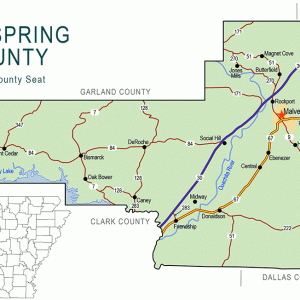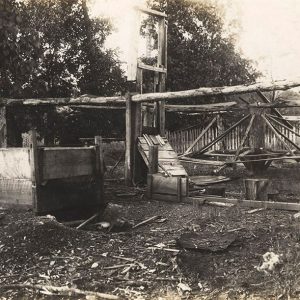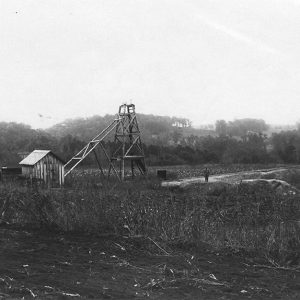calsfoundation@cals.org
Magnet Cove (Hot Spring County)
Located on Arkansas Highway 51 approximately twelve miles southeast of Hot Springs (Garland County), Magnet Cove of Hot Spring County has been a mecca for mineralogists, geologists, and rock hounds. Until recently, the available data indicated that there were more distinct minerals found in the five-square-mile radius of the cove than were found anywhere else on the planet; a small location in Russia is now believed to be comparable to Magnet Cove’s mineral deposits, many of which are microscopic.
General features and the external appearance suggest that “the cove” is an ancient volcanic crater. However, the current general consensus of opinion is that it was formed of intrusive (below the ground) igneous rock. Minerals formed in thin veins as a result of the passage of vapors and fluids released by the cooling magma penetrating outward.
Magnet Cove derives its name from its basin-like shape and the presence of magnetite (lodestone) in the soil. Early settlers in the area discovered the magnetite when their plows and other tools attracted the abundant lodestones.
Long before white settlers tilled the rocky soil, Native Americans frequented the Magnet Cove area seeking novaculite to fashion arrowheads, spears, and other tools necessary for daily life. Novaculite mining has been described as Arkansas’s first industry.
As in most areas of Arkansas, American settlers came to Magnet Cove as homesteaders in the early 1800s. They farmed and raised livestock. The present countryside is pastoral. Many residents today are descendants of the early settlers.
Logging has always been an important industry to the area. Before the development of roads and railroads, the giant hardwood trees were cut and floated down the nearby Ouachita River to the Mississippi River, then on to New Orleans.
German and Japanese scientists have reported that novaculite from the Magnet Cove Stone Quarry is pure to 99.49 percent silica, making it the only known location of novaculite of this quality. Quality novaculite from the Magnet Cove area is used for testing gold and as an industrial abrasive. It is also used in the space and aircraft industries as a grit and polish material.
If not for the minerals, Magnet Cove would be just another quiet, nondescript community in Arkansas. But the minerals bring worldwide attention to the area. Serious mineral collecting took place after Charles Shepard, a noted geologist and professor, published a paper in 1846 regarding the discovery of a new mineral, “arkansite.” He wrote that arkansite, a titanium oxide, was found only in Arkansas. After the advancement of modern technology, it was confirmed that arkansite was actually brookite, a known mineral. But the secret of mineral-rich Magnet Cove was spread. The area’s reputation for the abundance of titanium-rich minerals—like anatase, brookite, rutile, and perovskite, in addition to quality novaculite and magnetite—was global.
Through the efforts of dedicated mineralogists, field collectors, geologists, and local landowner Henry deLinde, several new minerals, including delindeite and lourenswalsite, were discovered in the Magnet Cove area. Other new minerals discovered were syncysite-(Ce) and a zirconium-rich garnet named kimzeyite. Perhaps the best kolbeckite crystals ever discovered anywhere in the world are found at Magnet Cove. Over seventy minerals have been confirmed to be present in the area.
Magnet Cove is the only location where good crystals of kimzeyite are collected. Kimzeyite is named after the Kimzey family, longtime residents of Magnet Cove who obtained and preserved mineral specimens from the area. Joe W. Kimzey, who was Arkansas State Geologist from 1943 to 1945, provided U.S. Geological Survey geologists with the garnet that would be named for his family.
There are no publicly owned lands for rockhounding in Magnet Cove. Those interested in collecting minerals need to get the permission of individual landowners.
The only businesses in Magnet Cove are a gas station and two novaculite quarries. Magnet Cove School District, founded in 1930, is located in the area. The enrollment in grades K-12 is near 800. The school is the only public land in Magnet Cove.
The community was incorporated in 2000 with 467 inhabitants. However, in December 2006, the community voted to suspend the incorporation after residents agreed that incorporation was not necessary.
For additional information:
Haltom, William L. “Magnet Cove, Arkansas, and Vicinity.” American Mineralogist 14 (1929): 484–487. Online at http://www.minsocam.org/MSA/collectors_corner/arc/armagnetn.htm (accessed August 31, 2023).
Key, Betty J. “History of Magnet Cove and Butterfield.” The Heritage 25 (1998): 45–60.
Milton, C., B. L. Ingram, and L. V. Blade. “Kimzeyite, A Zirconium Garnet from Magnet Cove, Arkansas.” American Mineralogist 46 (May-June 1961): 533–548.
Helen Pennington
Pine Bluff, Arkansas
 Benstonite
Benstonite  Hot Spring County Map
Hot Spring County Map  Kimzeyite
Kimzeyite  Shingle Mill
Shingle Mill  Titanium Mine
Titanium Mine 




Comments
No comments on this entry yet.